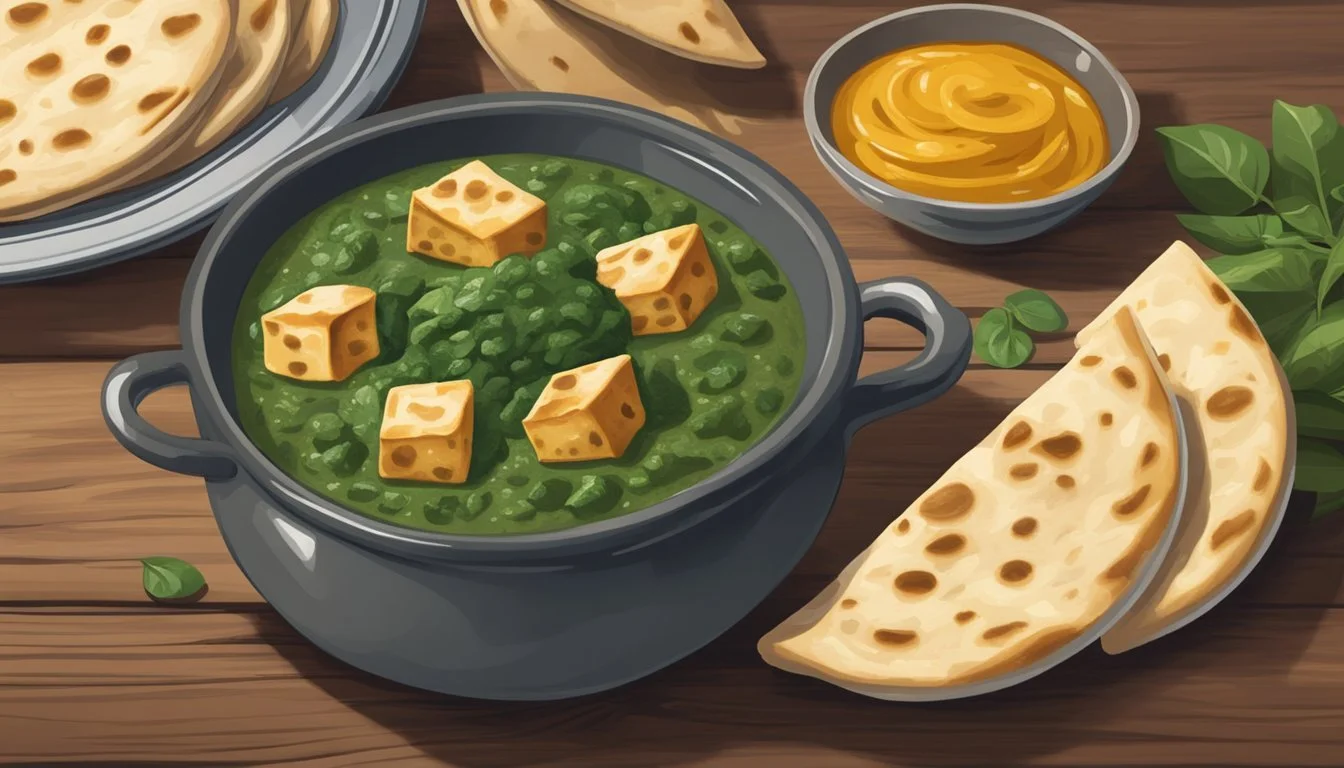How to Reheat Gluten-Free Saag Paneer Perfectly Every Time
Reheating gluten-free Saag Paneer can be a straightforward process when done correctly, ensuring that the creamy spinach base remains vibrant and the paneer cubes stay tender. Whether you’re using a microwave, oven, or stovetop, the goal is to maintain the dish's texture and flavor without compromising on quality.
For those mindful of dietary restrictions, it's crucial to ensure your Saag Paneer remains gluten-free during the reheating process. Using a microwave, place the dish in a microwave-safe container, cover it with a lid, and heat in short bursts to avoid overcooking. Stovetop reheating involves gently warming on low heat to prevent the paneer from becoming rubbery while keeping the spinach smooth and luscious.
Indian cuisine's beloved Saag Paneer deserves careful reheating to preserve its unique blend of spices and textures. Following these methods will allow you to enjoy a delicious, gluten-free serving of this classic dish, whether it's a quick lunch or a hearty dinner.
Understanding Saag Paneer
Saag Paneer is a traditional Indian dish featuring creamy spinach and soft paneer cheese. This section details what makes Saag Paneer a unique and nutritious culinary offering, including its key ingredients and gluten-free considerations.
Defining Saag Paneer
Saag Paneer combines spinach and other leafy greens with paneer, a type of Indian cheese. The greens are cooked with a blend of spices to create a rich, creamy sauce that envelops the paneer. This dish is popular in both Indian homes and restaurants, known for its distinctive flavors and satisfying texture.
Health Benefits
Saag Paneer offers multiple health benefits. Spinach is high in iron, essential for maintaining healthy blood cells. It is also a good source of vitamins A and C. Paneer cheese adds a significant amount of protein to the dish, making it suitable for vegetarians. The combination of ingredients supports overall wellness by providing essential nutrients.
Key Ingredients
Spinach: Provides a vitamin-rich base for the dish.
Paneer: A versatile, non-melting cheese that absorbs flavors well.
Spices: Common spices include turmeric, chili powder, and garam masala for a robust flavor profile.
Cream: Sometimes added for extra richness and texture.
Garlic and Ginger: Enhance the dish's aroma and taste.
Gluten-Free Considerations
Saag Paneer can easily be made gluten-free. Asafoetida (hing), sometimes used in Indian cooking, may contain gluten. Ensure that a gluten-free version of asafoetida is used. Additionally, verify that all spice blends are certified gluten-free. This adaptations ensures the dish is safe for those with gluten sensitivities or celiac disease.
Preparation of Gluten-Free Saag Paneer
Creating a delicious gluten-free Saag Paneer involves choosing the right ingredients and following an effective cooking process. Selecting fresh, gluten-free components ensures the final dish remains both flavorful and safe for those avoiding gluten.
Choosing Ingredients
Using *fresh, gluten-free ingredients is essential. Paneer cubes, a key component, should be checked for gluten sources.
Look for fresh spinach and, if needed, substitute with mustard greens. Next, acquire ghee as it imparts a rich flavor.
Spices play a crucial role, especially cumin, garam masala, and turmeric. Ensure that these spices are certified gluten-free to avoid cross-contamination. Additionally, fresh coriander leaves add a fragrant touch to the dish.
Initial Cooking Process
Begin by sautéing finely chopped onions, garlic, and ginger in ghee until golden.
Add the paneer cubes and lightly fry until they are slightly browned.
Next, incorporate cumin, garam masala, turmeric, and other desired spices to enhance the dish’s aroma.
Introduce the fresh spinach and some water, allowing the greens to wilt and mix well with the spices. Cover and cook for 5-8 minutes, ensuring the mixture becomes creamy.
Garnish with freshly chopped coriander leaves before serving. This method preserves the flavors and makes the dish nutritious and suitable for a gluten-free diet.
Proper Storage Techniques
Storing gluten-free saag paneer properly is essential to maintain its flavor and texture. This includes correct methods for cooling, refrigerating, and freezing the dish.
Cooling and Storing
To store saag paneer effectively, start by allowing the cooked dish to cool promptly. Leaving it out at room temperature for too long can affect both flavor and texture.
Transfer the saag paneer into an airtight container once it has cooled sufficiently. Refrigeration should be done within two hours of cooking to prevent bacterial growth. Use a container with a secure lid to keep the dish fresh and prevent contamination.
Refrigerated saag paneer can last up to three to four days. Label the container with the date it was prepared to keep track of its freshness.
Freezing Guidelines
Freezing saag paneer can extend its shelf life significantly while preserving its flavors. Ensure the dish is completely cooled before transferring it into a freezer-safe container.
When freezing, keep the paneer and the greens separate if possible. This helps maintain the texture of the paneer. Use food-safe, freezer-friendly containers or heavy-duty plastic bags, removing excess air to prevent freezer burn.
Saag paneer can be frozen for up to three months. For the best results, thaw it in the refrigerator overnight before reheating. This gradual thawing helps the dish retain its original consistency and flavor.
Effective Reheating Methods
There are several effective ways to reheat gluten-free saag paneer while retaining its texture and flavor. These methods include using a microwave, stovetop, oven or toaster oven, and an Instant Pot.
Microwave Instructions
To reheat saag paneer in the microwave, place the leftovers in a microwave-safe dish. Cover the dish with a microwave-safe lid or a damp paper towel to maintain moisture. Set the microwave to medium power and heat in 30-second intervals.
Stir the saag paneer between each interval to ensure even reheating. This prevents hotspots that can alter the texture. Continue this process until the dish is heated through, usually taking about 2-3 minutes total. Adjust the temperature settings if necessary based on your specific microwave.
Stovetop Technique
Reheating saag paneer on the stovetop preserves its creamy consistency well. Pour the leftovers into a non-stick pan and set the heat to low or medium. Stir occasionally to prevent sticking and uneven reheating.
If the saag paneer appears dry, add a tablespoon or two of water or cream to restore its moisture. Heat until the dish reaches your desired temperature, usually around 5-8 minutes. This method ensures the paneer retains its soft texture and the spinach mixture stays creamy.
Using an Oven or Toaster Oven
Preheat your oven or toaster oven to 350°F (175°C). Transfer the saag paneer to an oven-safe dish and cover it with aluminum foil to prevent moisture loss.
Place the dish in the oven and reheat for 15-20 minutes. Check and stir at the halfway mark to ensure even heating. If you notice the dish drying out, you can add a small amount of water or cream. This method is useful for reheating larger portions, ensuring everything is evenly warmed.
Instant Pot Reheating
Using an Instant Pot to reheat saag paneer is quick and efficient. Place the leftovers in a heatproof container that fits inside the pot. Add one cup of water to the bottom of the Instant Pot, and position the container on a trivet above the water.
Seal the lid and set the Instant Pot to the "Steam" function. Reheat for about 5 minutes under pressure. Once the time is up, perform a quick release of the steam. This method keeps your saag paneer moist and evenly heated.
Serving Suggestions
Saag Paneer pairs wonderfully with various accompaniments and garnishing tips that elevate its taste and presentation. Essential sides include Indian breads and rice, while thoughtful garnishing can enhance its flavor and appeal.
Accompaniments
Roti and Naan are classic choices. These Indian breads soak up the rich spinach gravy and provide a satisfying texture contrast. For a gluten-free option, consider tandoori roti made with gluten-free flours.
Basmati Rice is another excellent option. Its long grains complement the creamy saag, ensuring each bite is fragrant and flavorful. You can prepare it plain or with a dash of saffron for a subtle, aromatic twist.
Side Dish Choices like a cucumber raita or a simple salad with lemon juice offer a refreshing counterbalance to the rich and earthy flavors of Saag Paneer. They aid in digestion and cleanse the palate between bites.
Garnishing Tips
Adding a touch of garnish can significantly enhance the presentation and taste of your Saag Paneer. Consider sprinkling fresh lemon juice over the dish. This adds a bright, zesty flavor that cuts through the creaminess of the spinach and paneer.
Cream and Butter are also great finishing touches. A swirl of cream or a dot of butter on top not only looks appealing but also adds a layer of luxury.
Finally, fresh cilantro or chopped green chilies make excellent garnishes. Cilantro brings a fresh, herbal note, while green chilies add a hint of heat for those who prefer a spicy kick.
Recipe Variations and Substitutes
There are many ways to customize Saag Paneer to suit dietary preferences and restrictions. These variations include vegan alternatives, substitutions for common allergens, and adjustments to spice levels.
Vegan Alternatives
For a vegan version of Saag Paneer, substitutes such as tofu and coconut milk can replace traditional dairy products. Tofu, when pressed and marinated, works well as a substitute for paneer.
Use firm or extra-firm tofu. Marinate it with turmeric, salt, and green chili for extra flavor.
To replace cream, opt for coconut milk. It provides a creamy texture without dairy. Combine spinach and mustard greens with coconut milk for a rich, vegan-friendly dish.
Substitutes for Common Allergens
Individuals with dairy allergies can use firm tofu instead of paneer. Tofu mimics the texture of paneer when cooked correctly.
For those with nut allergies, avoid almond or cashew milk. Coconut milk or oat milk serve as great substitutes here.
Chili powder and milder spices can replace fresh green chilies for those sensitive to heat. This ensures the dish retains its flavor without being too spicy.
Sugar can be used to balance flavors if needed, especially when reducing the heat.
Adjusting Spice Levels
Spice levels in Saag Paneer can be modified according to personal preferences. For a milder version, reduce the amount of green chili and chili powder.
For those who prefer a spicier dish, increase the amounts of green chili and chili powder. Add these gradually and taste as you go to avoid excessively spicy results.
Keeping a balance is crucial. Use a little sugar to counteract too much heat if necessary. This ensures the dish remains enjoyable despite varied spice levels.
Final Thoughts
Reheating gluten-free saag paneer doesn't have to be a daunting task. Whether you choose to use a microwave, stovetop, or oven, maintaining the integrity of this traditional Indian cuisine dish is crucial.
When using the microwave, place the saag paneer in a microwave-safe dish and cover it to retain moisture. Heat it in short intervals, stirring occasionally.
For a stovetop method, heat a pan over medium-low heat, adding a splash of water or ghee to prevent sticking. Stir gently to preserve the soft texture of the paneer.
Oven reheating involves placing saag paneer in an oven-safe dish, covering it with foil, and baking at 300°F (150°C) until warmed through. This method is great for even heating without drying out the spinach.
The preservation of flavors is just as important as maintaining the textures. Punjabi sarson ka saag blends beautifully with paneer, and attention to detail ensures these flavors remain robust.
Using these methods, one can enjoy saag paneer as if it were freshly prepared. Indian food lovers know the value of well-executed reheating techniques.
Enjoy this vegetarian delight regularly by mastering these reheating tips. It offers not only convenience but also sustains the essence of the beloved dish.








